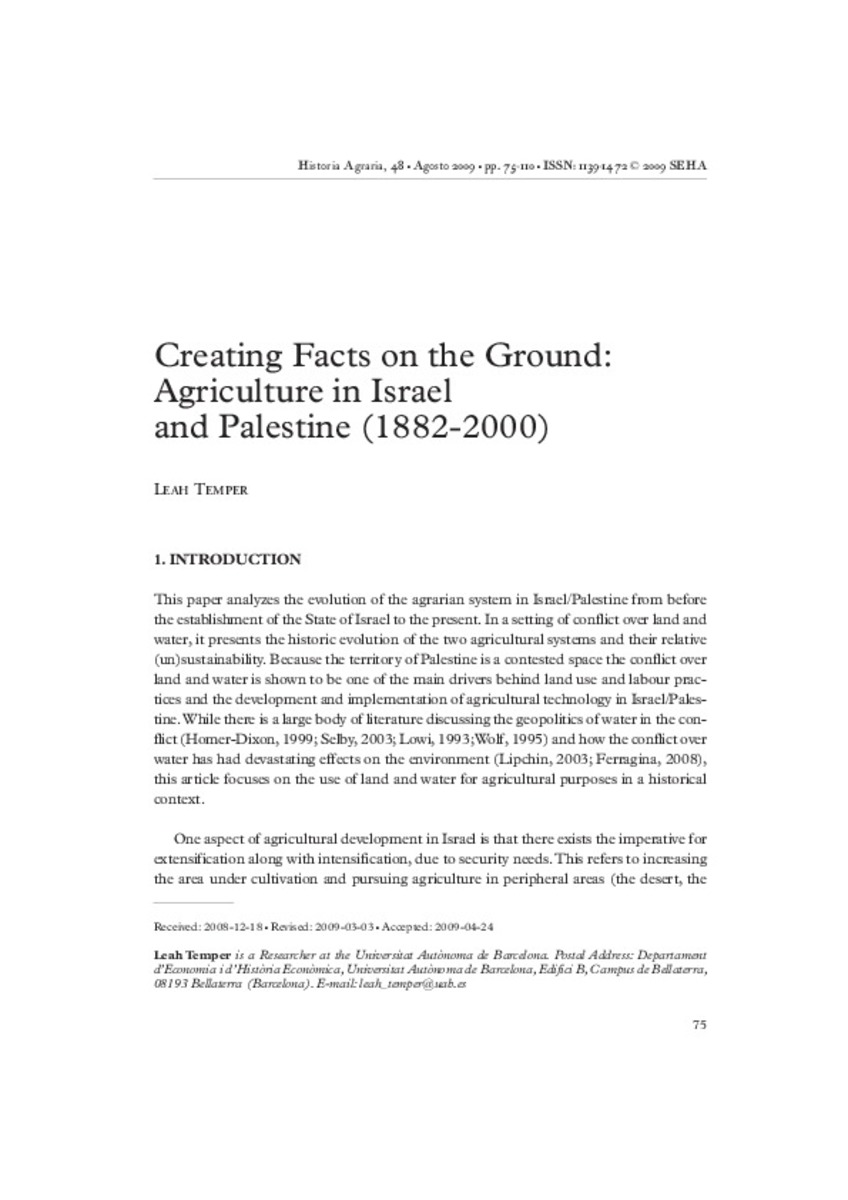Mostrar el registro sencillo del ítem
La agricultura en Israel y Palestina, 1882-2000. Creando hechos sobre el terreno.
| dc.contributor.author | Temper, Leah | |
| dc.date.accessioned | 2016-02-05T09:39:58Z | |
| dc.date.available | 2016-02-05T09:39:58Z | |
| dc.date.issued | 2009-08 | |
| dc.identifier.issn | 1139-1472 | |
| dc.identifier.uri | http://hdl.handle.net/10234/148686 | |
| dc.description.abstract | Este artículo describe cómo el conflicto sobre recursos de agua y tierra en el territorio de Israel/ Palestina ha configurado los sistemas agrícolas a ambos lados de la linea verde. Usando diversas fuentes, seguimos la evolución de los usos del suelo, las instituciones, y la innovación tecnológica desde el periodo Otomano hasta el presente. La agricultura Israelí es aplaudida en todo el mundo por sus organizaciones agrícolas como son los Kibbutzs o los Moshavs, y también por sus avances tecnológicos en el ahorro de agua, como el riego por goteo y la re-utilización de agua de desagüe. Examinando los apoyos institucionales del sistema agrícola israelí, este artículo examina la evolución de estos avances. También analizamos la agricultura Palestina y cómo el conflicto y el acceso restringido a los recursos han condicionado su evolución. En conclusión, discutimos cómo el conflicto territorial por encima de los recursos ha contribuido a la (in) sostenibilidad de ambos sistemas agrícolas. | ca_CA |
| dc.description.abstract | This article outlines how the conflict over land and water resources on the territory of Israel/Palestine has shaped the agricultural systems on either side of the green line. Using a variety of sources we trace the co‐evolution of land use practices, institutions and technological innovation from the Ottoman period to the present. Israeli agriculture is applauded around the world for its cooperative forms of agricultural organizations such as the kibbutz or moshav, as well as for water‐saving technological advancements including drip irrigation and wastewater re‐use. This article examines the evolution of these innovations, examining the institutional and ideological underpinnings of the unique agricultural system in Israel. We also examine Palestinian agriculture and how the conflict and restricted access to resources has shaped its evolution. In conclusion, it discusses how territorial conflict over resources has contributed to the (un)sustainability of the respective agricultural systems. | ca_CA |
| dc.format.extent | 35 p. | ca_CA |
| dc.format.mimetype | application/pdf | ca_CA |
| dc.language.iso | eng | ca_CA |
| dc.publisher | Sociedad Española de Historia Agraria (SEHA) | ca_CA |
| dc.relation.isPartOf | Historia agraria: Revista de agricultura e historia rural, nº 48, p. 75-110 | ca_CA |
| dc.rights | © 2009 SEHA | ca_CA |
| dc.rights.uri | http://rightsstatements.org/vocab/InC/1.0/ | * |
| dc.subject | usos del suelo | ca_CA |
| dc.subject | riego | ca_CA |
| dc.subject | conflicto de recursos | ca_CA |
| dc.subject | injusticia ambiental | ca_CA |
| dc.subject | tecnología | ca_CA |
| dc.subject | land use | ca_CA |
| dc.subject | irrigation | ca_CA |
| dc.subject | resource conflict | ca_CA |
| dc.subject | environmental injustice | ca_CA |
| dc.subject | technology | ca_CA |
| dc.title | La agricultura en Israel y Palestina, 1882-2000. Creando hechos sobre el terreno. | ca_CA |
| dc.type | info:eu-repo/semantics/article | ca_CA |
| dc.subject.jel | N5 | ca_CA |
| dc.subject.jel | Q15 | ca_CA |
| dc.subject.jel | Q55 | ca_CA |
| dc.subject.jel | R14 | ca_CA |
| dc.rights.accessRights | info:eu-repo/semantics/openAccess | ca_CA |
| dc.relation.publisherVersion | http://historiaagraria.com/info_articulo.php?id=487 | ca_CA |







